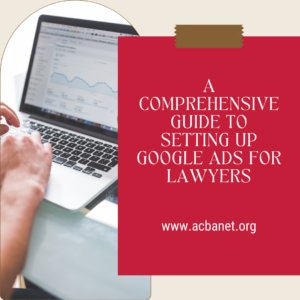 In today’s digital age, online advertising plays a vital role in helping businesses connect with their target audience. For lawyers, Google Ads is an excellent platform to reach potential clients. By leveraging Google’s vast network and powerful targeting options, you can ensure that your law practice stands out among the competition. In this blog post, we will provide a step-by-step guide on how to set up Google Ads for lawyers, enabling you to maximize your online visibility and drive relevant traffic to your website.
In today’s digital age, online advertising plays a vital role in helping businesses connect with their target audience. For lawyers, Google Ads is an excellent platform to reach potential clients. By leveraging Google’s vast network and powerful targeting options, you can ensure that your law practice stands out among the competition. In this blog post, we will provide a step-by-step guide on how to set up Google Ads for lawyers, enabling you to maximize your online visibility and drive relevant traffic to your website.
Step 1: Define Your Advertising Goals
Before diving into the technical aspects, it’s essential to establish clear objectives for your Google Ads campaign. Determine whether you want to generate more leads, increase website traffic, promote a specific service, or raise brand awareness. This clarity will guide your entire campaign setup and optimization process.
Step 2: Keyword Research
Keyword research is a crucial step in any successful Google Ads campaign. Identify the keywords and search terms that potential clients are likely to use when looking for legal services. Focus on long-tail keywords that are specific to your practice area and location. Use tools like Google Keyword Planner, SEMrush, or Moz to discover relevant keywords and assess their search volume and competition level.
Step 3: Create Compelling Ad Copy
Crafting persuasive ad copy is crucial to attract potential clients. Write concise, attention-grabbing headlines that address the needs of your target audience. Highlight the unique selling points of your law firm and clearly communicate the benefits of choosing your services. Incorporate relevant keywords into your ad copy to improve its visibility and quality score. If you need more help, try using ChatGPT.
Step 4: Set Up Campaigns and Ad Groups
Google Ads operates on a campaign and ad group structure. Start by creating campaigns based on your advertising goals. For instance, you can have separate campaigns for personal injury law, family law, or corporate law. Within each campaign, set up ad groups that target specific keywords and ad themes. Organizing your campaigns and ad groups effectively helps optimize your ads and monitor their performance more efficiently.
Step 5: Define Targeting Options
To ensure your ads reach the right audience, use Google Ads’ targeting options. Specify your desired geographic location to focus on your local market. If your practice serves a particular region, target that area exclusively. Additionally, define demographic factors such as age, gender, and income to narrow down your audience. Refine your targeting as needed to maximize the relevance of your ads.
Step 6: Optimize Landing Pages
A well-optimized landing page is vital for a successful Google Ads campaign. Ensure that the page you link your ads to aligns with the specific keywords and ad themes. Provide relevant and valuable information about your legal services to potential clients. Make the landing page user-friendly, easy to navigate, and mobile-responsive. Include clear call-to-action (CTA) buttons to encourage visitors to contact you or schedule a consultation.
Step 7: Monitor, Analyze, and Optimize
Once your campaigns are up and running, regularly monitor their performance to make data-driven decisions. Keep an eye on key metrics such as click-through rate (CTR), conversion rate, cost per click (CPC), and return on ad spend (ROAS). Identify underperforming keywords, ad groups, or campaigns and make necessary adjustments. Experiment with different ad variations, bid strategies, and targeting options to optimize your results continually.
If you need more help, there are companies that can manage your campaigns for you, but we hope this helps kickstart your marketing efforts. For more ideas on how to boost your practice, check out our blog.
